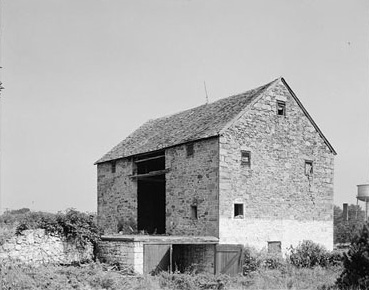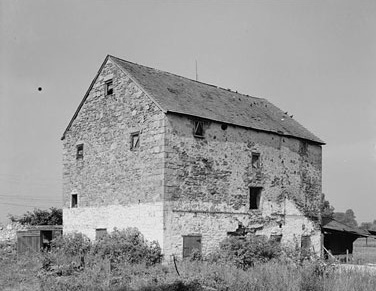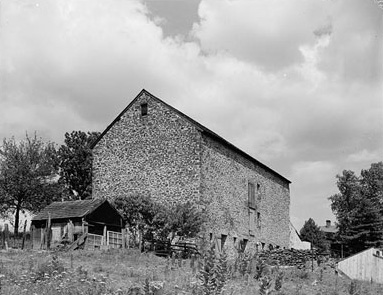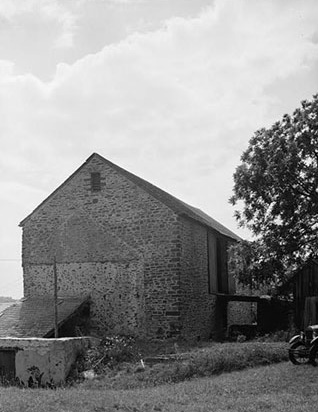Double Decker Barn
The term "double decker" is somewhat misleading, since these barns have three levels, not two. The lower level has stables for animals. Above that, the central level extends just one bay across from eaves side to eaves side. This tunnel-like effect creates space for a granary, and it also creates two deep "sink mows" extending from the stable ceiling all the way to the roof. Diagnostic features include a bridge on the bank side. This exposes a door that leads to the granary. On the opposite side, from outside typically it is possible to discern the three levels. These barns are most common in southeastern Pennsylvania; they generally appeared in the late 18th and early 19th century. Their tremendous hay storage capacity is evidence for the possibility that these barns reflect the surge in commerce after major improved roads created access to Philadelphia markets.

Double decker barn, near Doylestown, Bucks County, date unknown.
Note the bridge.
HABS photo. HABS PA,9-DOYLT.V,3A--2

Double decker barn, near Doylestown, Bucks County, date unknown
The three levels are clearly visible.
HABS photo. HABS PA,9-DOYLT.V,3A--1

Double decker barn, Newtown Township, Bucks County, 1810.
HABS photo. HABS PA,9-NETO.V,2A--1

Double decker barn, Newtown Township, Bucks County, 1810.
HABS photo. HABS PA,9-NETO.V,2A--2
Note
This is a static, archived version of the PHMC Pennsylvania Agricultural History Project website which will not be updated. It is a snapshot of the website with minor modifications as it appeared on August 26, 2015.
Pages in this Section
- Overview
- House Types
- Barn Types
- Barn Features
- Outbuilding Types
- Overview
- Bake Oven
- Butcher House
- Carriage House
- Cider House
- Combination Structure
- Cook House
- Corn Crib
- Dryhouse
- Fruit Cold Storage
- Garage
- Grain Bin
- Granary
- Greenhouse
- Hay Drying Shed
- Hog House
- Horse Barn
- Ice House
- Machine Shed
- Maple Sugar House
- Milk House
- Packing House
- Potato Storage Cellar
- Poultry Housing
- Privy
- Roadside Stand
- Root Cellar
- Scale House
- Shed
- Silo
- Smokehouse
- Spray Shed
- Springhouse
- Summer Kitchen
- Wagon Shed
- Wash House
- Wood Shed
- Worker Housing
- Workshop
- Landscape Elements
- Archaeological Features